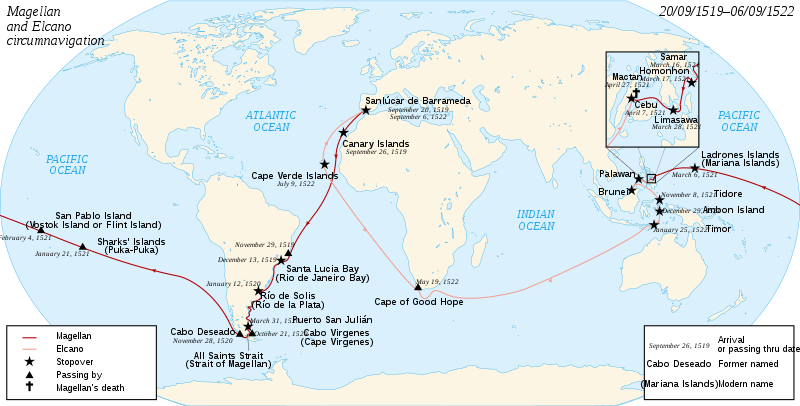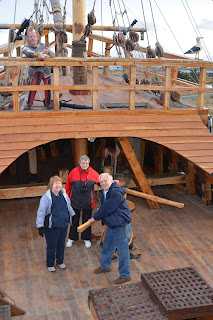One of the real highlights of our trip was our visit to a full-sized replica of Ferdinand Magellan's ship, the Victoria. Magellan was a Portuguese explorer whose expedition of 1519-1522 included five ships and a total of 270 men. They were searching for a westward route to the Spice Islands, the Philippines. They became the first to sail from the Atlantic Ocean into the Pacific Ocean, through what is now known as the Straits of Magellan, and the first to cross the Pacific. The expedition also completed the first circumnavigation of the Earth, although Magellan himself did not complete the entire voyage. He was killed in a battle in the Philippines.

Magellan's second in command, Juan Sebastian Elcano, eventually returned to the home port in Spain almost three years after the expedition had initially sailed. Victoria managed to pull through and return to Spain with a shipload of spices. The ship was in terrible shape, with her sails torn and only kept afloat by continuous pumping out of water. The Victoria was the one surviving ship of the five, and 18 men out of the original 237 men were on board. Many had died of malnutrition. They had travelled 42,000 miles, 22,000 miles of which much was unknown to the crew.
 |
| the Victoria |
 |
| one of the builders |
 |
| the view from the 'aft' |
 |
| the forecastle, designed for defense |
The Victoria carried a crew of 42, and living conditions were cramped, unless you were the captain.
 |
| 'tween decks |
The Captain had more spacious accommodations.
The rudder was controlled from the deck with a simple "stick".
 |
| Revell demonstrates the rudder to Lloyd and our bus driver. |
 |
| Anchors Away! |
 |
| Captain Teresa |
It was such a treat to be able to climb all over this lovely ship, which was a Spanish carrick of 85 tons, and only about 60-70 ft (18 - 21 m) in length. Although Revell cautioned us not to accept if offered a chance to go to sea on this replica, as it is not seaworthy, it gave us a real sense of the scale of these early ships. We could not imagine the courage that it took to sail into unknown, stormy waters in such a small vessel. the 'castles' at either end must have made the ship toss in the wind and waves.
A story for those of you who like history and adventure:
A man with leadership and 'true grit': Ernest Shackleton
After several successful Antarctic expeditions, Shackleton planned to attempt his "Imperial Trans-Antarctic Expedition", late in 1914. Two ships would be employed; Endurance would carry the main party into the Weddell Sea on the northern coast of Antarctica, from where a team of six, led by Shackleton, would begin the crossing of the continent. Meanwhile a second ship, the Aurora, would take a supporting party to McMurdo Sound on the opposite side of the continent. This party would then lay supply depots across the Great Ice Barrier as far as the Beardmore Glacier, these depots holding the food and fuel that would enable Shackleton's party to complete their journey of 1,800 miles (2,900 km) across the continent. Shackleton was well known by this time and received 5000 applications to join the expedition.
In January 1915, Endurance became frozen fast in an ice floe. After a month, Shackleton ordered the abandonment of ship's routine and her conversion to a winter station. She drifted slowly northward with the ice through the following months. When spring arrived in September the breaking of the ice and its later movements put extreme pressures on the ship's hull. On 24 October, however, water began pouring in. After a few days, Shackleton gave the order to abandon ship, saying, "She's going down!"; and men, provisions and equipment were transferred to camps on the ice. On 21 November 1915, the wreck finally slipped beneath the surface.
For months Shackleton and his party camped on several different ice floes, hoping that first one and then the other would drift towards Paulet Island, approximately 250 miles (402 km) away, where it was known that stores were cached. By 17 March their ice camp was within 60 miles (97 km) of Paulet Island but, separated by impassable ice, they were unable to reach it. On 9 April their ice floe broke into two, and Shackleton ordered the crew into the lifeboats, to head for the nearest land. After five harrowing days at sea the exhausted men landed their three lifeboats at Elephant Island, 346 miles from where the Endurance sank. This was the first time they had stood on solid ground for 497 days. Shackleton's concern for his men was such that he gave his mittens to photographer Frank Hurley, who had lost his during the boat journey. Shackleton suffered frostbitten fingers as a result.
Elephant Island was an inhospitable place, far from any shipping routes. Consequently, Shackleton decided to risk an open-boat journey to the 800 mile distant South Georgia whaling stations, where he knew help was available. The strongest of the tiny 20-foot (6.1 m) lifeboats, christened James Caird after the expedition's chief sponsor, was chosen for the trip. The ship's carpenter made various improvements, including raising the sides, strengthening the keel, building a makeshift deck of wood and canvas, and sealing the work with oil paint and seal blood.
 |
| Launching the James Caird from the shore of Elephant Island, 24 April 1916 |
 |
| Said to be the original James Caird |
Shackleton immediately sent a boat to pick up the three men from the other side of South Georgia while he set to work to organise the rescue of the Elephant Island men, who had been isolated there for four and a half months. His first three attempts were foiled by sea ice, which blocked the approaches to the island. He appealed to the Chilean government, which offered the use of a small seagoing tug from its navy. Yelcho reached Elephant Island on 30 August, and Shackleton quickly evacuated all 22 men. The Yelcho took the crew to Valparaiso, Chile, where crowds warmly welcomed them back to civilisation.
There remained the men of the Ross Sea Party, who were stranded at Cape Evans in McMurdo Sound, after Aurora had been blown from its anchorage and driven out to sea, unable to return. The ship, after a drift of many months, had returned to New Zealand. Shackleton travelled there to join Aurora, and sailed with her to the rescue of the Ross Sea party. This group, despite many hardships, had carried out its depot-laying mission to the full, but three lives had been lost, including that of its commander, Aeneas Mackintosh. adapted from Wikipedia












No comments:
Post a Comment